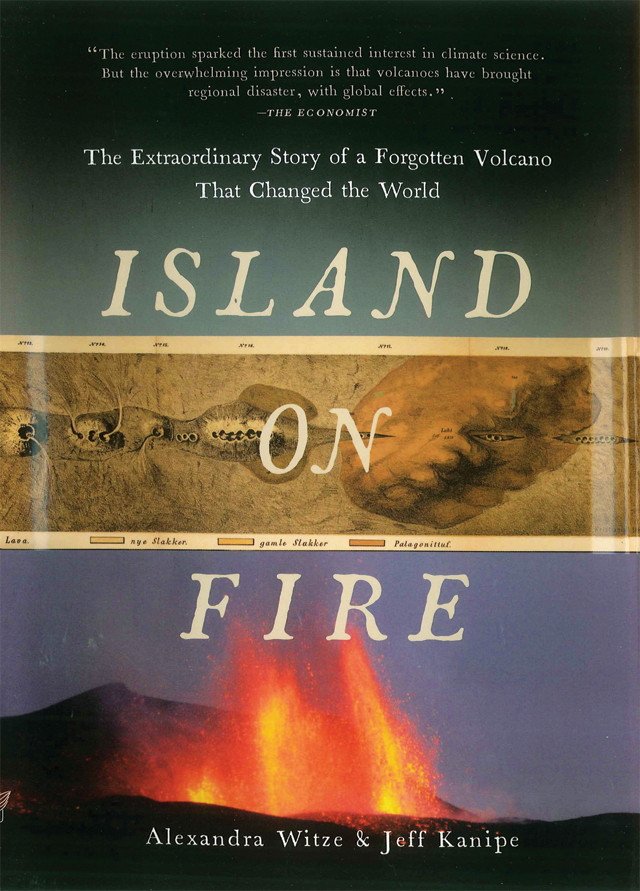
by Erik Klemetti Tuesday, July 7, 2015

"Island on Fire: The Extraordinary Story of a Forgotten Volcano That Changed the World," by Alexandra Witze and Jeff Kanipe, Pegasus, 2015, ISBN: 978-1605986746.
For a few months in 2014–2015, a volcanic eruption in Iceland captivated many people around the world. The Holuhraun lava field produced the largest volume of lava erupted on the North Atlantic island in the past 200 years. Except for the areas plagued with acrid, sulfur-rich gas, which affected air quality, the eruption was mostly harmless and became a tourist spectacle. It was Icelandic volcanism at its finest.
Turn back the clock to the 1783 Laki eruption, however, and the story is different. This is the tale that Alexandra Witze and Jeff Kanipe tell in their book “Island on Fire: The Extraordinary Story of a Forgotten Volcano That Changed the World.” As large as the Holuhraun eruption seemed to the modern observer, it didn’t hold a candle to Laki, which disgorged 10 times as much lava — an estimated 14 cubic kilometers over eight months. The Laki eruption was stunning for the people of Iceland, as Witze and Kanipe capture vividly, but it also had a large impact on global climate and society. These events occurred well before the advent of modern volcanology, so they have to be unraveled from historic records left in Iceland and around the world. This is where Witze and Kanipe excel.
Based on these records, the authors examine the myriad ways that the Laki eruption impacted Iceland, both near the voluminous lava flows and across the island. The central character of “Island on Fire” turns out not to be the lava, but rather an unassuming preacher named Jón Steingrímsson. It is through his eyes that we experience the events before, during and after Laki. Steingrímsson’s detailed and vivid descriptions of the eruption, which, thankfully, he wrote down, captured the contemporary perceptions of an educated man of the Icelandic countryside who, from time to time, interpreted the events as biblical. And it is his journals, primarily, that allowed Witze and Kanipe to give modern readers a thorough retelling of events, as well as a glimpse into how people experienced the eruption at the time.
The writers describe the dominoes that fell following the Laki eruption, as Icelanders succumbed to starvation, disease and despair. In the 1780s, little was known outside of Iceland about this humanitarian catastrophe. And even today, it is largely forgotten in the mainstream conscience, partly because a detailed and accessible record like “Island on Fire” hasn’t existed, and also because it has been overshadowed by popular recountings of other devastating eruptions like Krakatoa and Vesuvius. Witze and Kanipe reincarnate the suffering caused both directly and indirectly by Laki, making it an excellent lesson on what can happen to people unprepared for cataclysm.
Presented much like a disaster movie, the story of the global ramifications of the eruption at Laki is progressively revealed. Witze and Kanipe draw almost every calamitous meteorological, agricultural and social event of the 1780s into Laki’s sphere of influence, starting in Europe and spreading globally. However, the authors don’t implicate Laki as the sole cause of these phenomena and never stray into sensationalizing the event.
The book brings to life a globally significant event, and will likely captivate readers who are unfamiliar with Laki, especially with the tale spun through Steingrímsson’s eyes. If anything, as you read the book, you’ll likely want more of Steingrímsson’s observations and emotions as these events — which must have seemed to him like God’s wrath manifest — unfolded.
There are parts of “Island on Fire” that might frustrate volcanophiles who pick up the book. The chapter on supervolcanoes feels superfluous, especially because Iceland’s brand of basaltic volcanism is very different from the massive, caldera-forming eruptions created by supervolcanoes. Similarly, some of the tales of death at other eruptions feel like retreads of what has been covered elsewhere in the popular press. However, in the chapter titled “Death by Volcano,” Witze and Kanipe make a fascinating comparison between the dry fogs generated by Laki and the industrial smog in the U.S. and England during the middle of the 20th century.
In the end, what makes “Island on Fire” work is the people in the book. The eruption was a slow-motion disaster that unfolded over years to decades. The weaving by Witze and Kanipe of the volcanology of the Laki eruption with stories of people who lived through the event make it required reading for anyone interested in how the repercussions of volcanoes (or any climate-altering event) can spread from local to global.
© 2008-2021. All rights reserved. Any copying, redistribution or retransmission of any of the contents of this service without the expressed written permission of the American Geosciences Institute is expressly prohibited. Click here for all copyright requests.